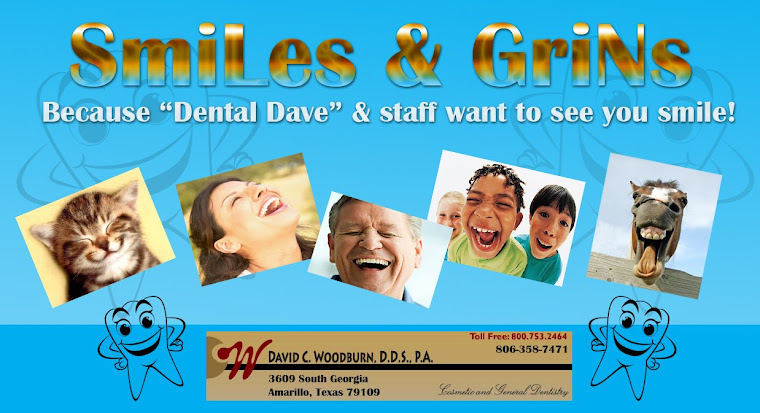
Saturday, December 31, 2011
Friday, December 30, 2011
Wednesday, December 28, 2011
Top 3 excuses for not flossing

A 2010 survey found that only 49% of Americans floss daily, and 10% never floss. That’s most unfortunate, dentists say, because flossing is even more important than brushing when it comes to preventing periodontal (gum) disease and tooth loss.
"If you were stuck on a desert island and a boat could bring only one thing, you’d want it to bring floss,” says Samuel B. Low, DDS, professor of periodontology at the University of Florida College of Dentistry in Gainesville, and president of the American Academy of Periodontology. “But I’m convinced that the only time some of my patients floss is an hour before showing up in my office.”
Dentists say they hear all sorts of excuses for not flossing. Yet they insist that simple workarounds exist for just about all:
Excuse #1: Food doesn’t get caught between my teeth, so I don’t need to floss.
Flossing isn’t so much about removing food debris as it is about removing dental plaque, the complex bacterial ecosystem that forms on tooth surfaces between cleanings. Plaque is what causes tooth decay, inflamed gums (gingivitis), periodontal disease -- and, eventually, tooth loss. Flossing or using an interdental cleaner is the only effective way to remove plaque between teeth.
Excuse #2. I don’t know how to floss.
Flossing isn’t easy. Low calls it “the most difficult personal grooming activity there is.” But practice makes perfect.
Here’s how the American Dental Association describes the process:
Start with about 18 inches of floss. Wrap most of it around the middle finger of one hand, the rest around the other middle finger.
Grasp the floss tightly between your thumbs and forefingers, and use a gentle shoeshine motion to guide it between teeth.
When the floss reaches the gum line, form a C shape to follow the contours of the tooth.
Hold the floss firmly against the tooth, and move the floss gently up and down.
Repeat with the other tooth, and then repeat the entire process with the rest of your teeth (“unspooling” fresh sections of floss as you go along).
Don’t forget to floss the backs of your last molars. “By far, most gum disease and most decay occurs in the back teeth,” Low says.
Excuse #3. I’m not coordinated enough to floss.
Many tooth-cleaning options exist for people whose manual dexterity is compromised by poor coordination, hand pain, paralysis, and amputations -- or simply by fingers that are too big to fit inside the mouth.
One option is to use floss holders. These disposable plastic Y-shaped devices (some equipped with a spool of floss) hold a span of floss between two prongs to allow one-handed use.
Monday, December 12, 2011
Wednesday, December 7, 2011
Ten Tips For Calming Dental Fears

Ten Tips For Calming Dental Fears
1. Tell the dentist about your fears. This information will help the dentist determine how to best manage and address those fears. By letting the dentist know exactly why the experience is difficult for you, you will feel more control in the examination chair.
2. Remember that dental procedures have greatly improved in the past few years. Modern dentistry offers new methods and treatment options to make you feel comfortable.
3. Your dentist can explain the entire procedure to you beforehand, as well as walk you through step-by-step while the procedure is being performed. You always have the right to fully understand the work being done on your teeth.
4. Consider additional medication to relax. Many dentists recommend nitrous oxide, sedation or anti-anxiety medicine for extremely nervous patients. Find a dentist who offers these options to help you get through the visit.
5. Find a dentist you are comfortable with and establish a trusting relationship. There are many personalities in the dental profession. Find a dentist who makes you feel at ease and is willing to work with you on your fears.
6. Breathe deeply and try to relax. Some dentists recommend practicing relaxation techniques before and during the appointment. Other dentists find that listening to music, or scheduling an appointment first thing in the morning, before the stresses of the day add up, also help patients to relax.
7. Talk to the dentist about stopping if you're uncomfortable. Many of the dentists surveyed said they establish a signal to "stop" with their patients. This puts you in control of the procedure and alerts the dentist if you're uncomfortable or need to take a break during the appointment.
8. Visit the dentist regularly to prevent problems. For fearful patients, just going for a check up can be nerve-wracking, but the more you go to the dentist for routine cleanings, the more likely you are to avoid larger problems that result in extensive procedures.
9. Visit the office and talk to the staff before your first appointment. You should feel free to meet with the dentist and to ask questions before scheduling your appointment. Meeting the dentist and his or her staff first will help you find a dentist you like and trust.
10. Go slow. Dentists are happy to go slow with nervous patients. If possible, make sure your first visit is a simple one, such as a cleaning. This will help you build your relationship with the dentist before going in for a more difficult procedure.
Subscribe to:
Posts (Atom)



